Croatia – Central, Međimurje (Zagreb, Karlovac, Lika-Senj) March, 2019
In March I came from Rijeka to see the most western sites of Central Croatia. The original plan was to go into the extreme west of Bosnia but the drives were simply too long so I went straight to Zadar. I ended up in the area anyway in mid-May.
Gomirje Monastery. About 50 km east of Rijeka, it is only 4kms south of the large expressway. The two-story monastery surrounds the lovely yellow church with its bell tower and dome. When I arrived, mass was just ending and most of the parish was taking communion. There are no pews in the small orthodox church and the entire congregation was standing. Lovely hymns were being sung. Heavy incense filled the air. A nice screen painted with icons separated the nave from the apse, as in most orthodox churches.
Plitvice Lakes National Park. A World Heritage Site, the park is on the western fringe of Central Croatia. The lakes fill the bottom of a deep limestone gorge, each joined by small cascading waterfalls. The water is bright green and very clear. Boardwalks are used to walk between them.
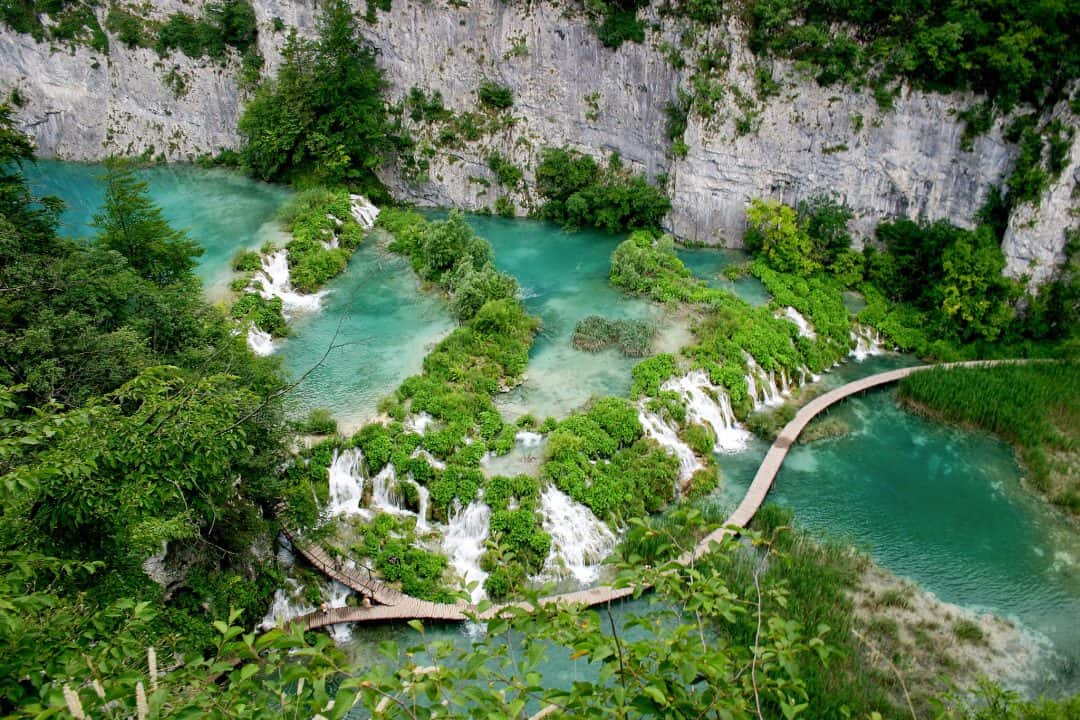
Veliki Slap. The Great Waterfall is the highest waterfall in the Plitvice Lakes National Park. It is located at the very end of the Lower Lakes, near the entrance to the national park. The upper falls cascade over the rim of the canyon 78 meters into a pool then continue as several smaller falls into a lower pool. The best access is from the west where long switchbacks descend from the large parking lots. Boardwalks give access to the pool below the falls. A much steeper trail descends from the west side (the side of the falls). There are nice viewpoints here. After the waterfall, the river continues down the deep limestone gorge.
In the winter the waterfall is almost completely frozen, making a giant ice sculpture of enormous magnitude.

Croatia – Central, Međimurje (Zagreb, Karlovac, Lika-Senj) May 15-,17, 2019
On May 15, I returned to Central Croatia in the far west from Bosnia and Herzegovina. My original route was to see the Caves of Barać, but the nearby border was closed and I ended up having to go much farther north. After 4 or 5 days of rain, most of the rivers were near-flood stage and in Karlovac, some streets had flooded and many areas were sandbagged.
TIPS and OBSERVATIONS on CROATIA
1. This is the most “Europeanized” country in the Balkans (similar to Slovenia). It has a completely different look and feel from N Macedonia, Kosovo and Bosnia and Herzegovina.
There are large tolled expressways, Lidl grocery stores and McDonalds. Everything looks more prosperous. Zagreb has many old buildings and wonderful architecture. It looks like it never had any war damage unlike everywhere else that took a beating in both World Wars and the Balkan wars of 1992-1999.
2. It is almost all Roman Catholic with a small Muslim population. The alphabet is Latin. I can’t help but believe having a Cyrillic alphabet is an economic and educational detriment. Most people speak good English. All these promote a better economy.
3. Prices are also higher. I didn’t fill up with gas, but diesel is about €1.27/litre.
3. It appears that Google is blocked in Croatia – at least I couldn’t access it unless I used my VPN. I’m not sure what else may be blocked.
4. Currency: Croatian Kuna – HRK (usually shortened to KN). In May 2019, 1 € = 7.43 KN.
Rastoke. In the NM “Small Towns” series, this one actually had something worthwhile seeing. The Jesenica River originating in the Mala Kapela Mountains flows for 6 km and then disappears continuing as a subterranean track for about 20 km to reemerge as the Slunjćica River south of Slunj. The Slurjčica River flows into the Korana River at Rastoke where there is a natural travertine barrier with the lower part of Rastoke having 23 waterfalls about 10-29m high falling into the Korana. The most famous are the English and English Fairy hair waterfalls.
Rastoke is known for its water-powered mechanical mills. The bottom of the houses are travertine rock and the upper parts are wood with shingle or tile roofs. Calcium sediment has sealed the openings of the cellar stones covering them with sinter so that water cannot run into the houses even at high water levels.
At its peak, Rastoke had 22 mills dating back to the 17th century. The mills were driven by horizontally aligned paddle wheels and water could be diverted whenever necessary to turn millstones. Every house had 2 or 3 millstones to grind “black corn” (maize, rye, barley, millet and oats) and “white corn (wheat). Waterpower was also used to pound or finalize woollen cloth and washing machines using water-driven wood barrels.
The best way to appreciate the town is from the road across the Korana River. Storyboards discuss the formation of tufa by the heavily mineralized water.
In the 1991-95 War in Croatia, Serb bombs damaged many of the roofs of the traditional houses and some of the waterfalls by throwing explosives into them. The attempts to destroy the giant road bridge across the Korana were unsuccessful.
KARLOVAC. A NM “European City”, this town has little that stands out, other than the fact it was flooding.
Karlovac Museum. Like all city museums, it has archaeology from the Stone Age, rocks, some natural history and many documents of the city and area.
Ozalj Castle (Castle Turk), Ozalj. About 9kms north of Karlovac, this is small rectangular “castle” is a complete ruin with about half of the one-story wall remaining and completely overgrown by trees. There was a large abandoned manor house next to it. All were signed “Private”. Free
Zagreb was a 45km drive on the first big expressway I had driven on for a month. With a speed limit of 130km/hr, some drivers were going at autobahn speeds. The toll was €4.60, about the same €1/10kms that you pay everywhere.
I went to a VW dealer to try to arrange an oil change but they were booked up for a week and referred me to a nearby Skoda dealer who made an appointment for 1 pm the next day. VW recommends an oil change at an unbelievable 40,000km and my odometer was at about 31,000km (I change the oil in my Chev diesel at home every 6,000 km).
ZAGREB/VELIKA GORICA
TIPS for ZAGREB
1. Zagreb Card. Good at only 5 museums (and a discount at others – see page 16 in the guide), all public transport (but downtown Zagreb is easy walking, but does count for the funicular), and about 45 other attractions. 98 for 24 hours, 130 for 72 hours). Includes Zagreb 360° observation deck (worth 60M and was not on the NM list, but I went up).
2. Parking is impossible anywhere close to downtown. The parking meters use an SMS code method of payment that I had not been able to figure out before, so I parked in an underground parkade in the middle of central Zagreb. The cost for 8 hours was a whopping 126 HRK.
3. Some things not done in North America are legal here: talking and texting on phones when driving and smoking in restaurants and coffee shops.
This was a big walkabout day. I saw 23 Nomad Mania sights, a possible record (Zagreb is an NM World City, World Capital and European city). I see museums (especially art galleries) very quickly. I have seen most things before and speed-read the labels and storyboards that interest me. The best museums have terse labels. Churches and markets (I rarely buy anything) are fast.
Zagreb Trams. Zagreb’s public transportation system uses trams. Painted blue, there are some old and mostly new trams in the system. Free with the Zagreb Card.
Zagreb Funicular. The old part of Zagreb (Velika Gorica) sits on a low flat hill. I took it up and down. 5 KN (free with Zagreb Card)
St. Catherine of Alexandria. With a plain white façade and 5 sculptures in niches, the interior of this Roman Catholic church is nice with no aisles, rib vaulted ceiling and pink with white stucco vines everywhere inside. There are several nice marble altars and paintings in the ceiling.
Museum of Broken Relationships. People from all over the world have contributed personal mementos of failed relationships reproduced in eclectic and often hilarious vignettes: a scab from a bicycle accident, herpes cream, a tree branch from a tree planter in the Kootenays (where I lived for 30 years), ashes from a dead father, a toaster, dildo. All quite enjoyable, but there is a lot of reading. 40 KN (reduction with Zagreb card)
Croatian Museum of Naïve Art. The Naïve period of art was from roughly the 1930’s to 1980 focusing on the Hlebine School. This is a lovely museum with paintings mostly of a cartoonish style, bright colours, simple themes and a whimsical touch. There are also wood carvings, pen and ink drawings and paper mache. The best artist was Ivan Generalić (1914-92). 25 KN
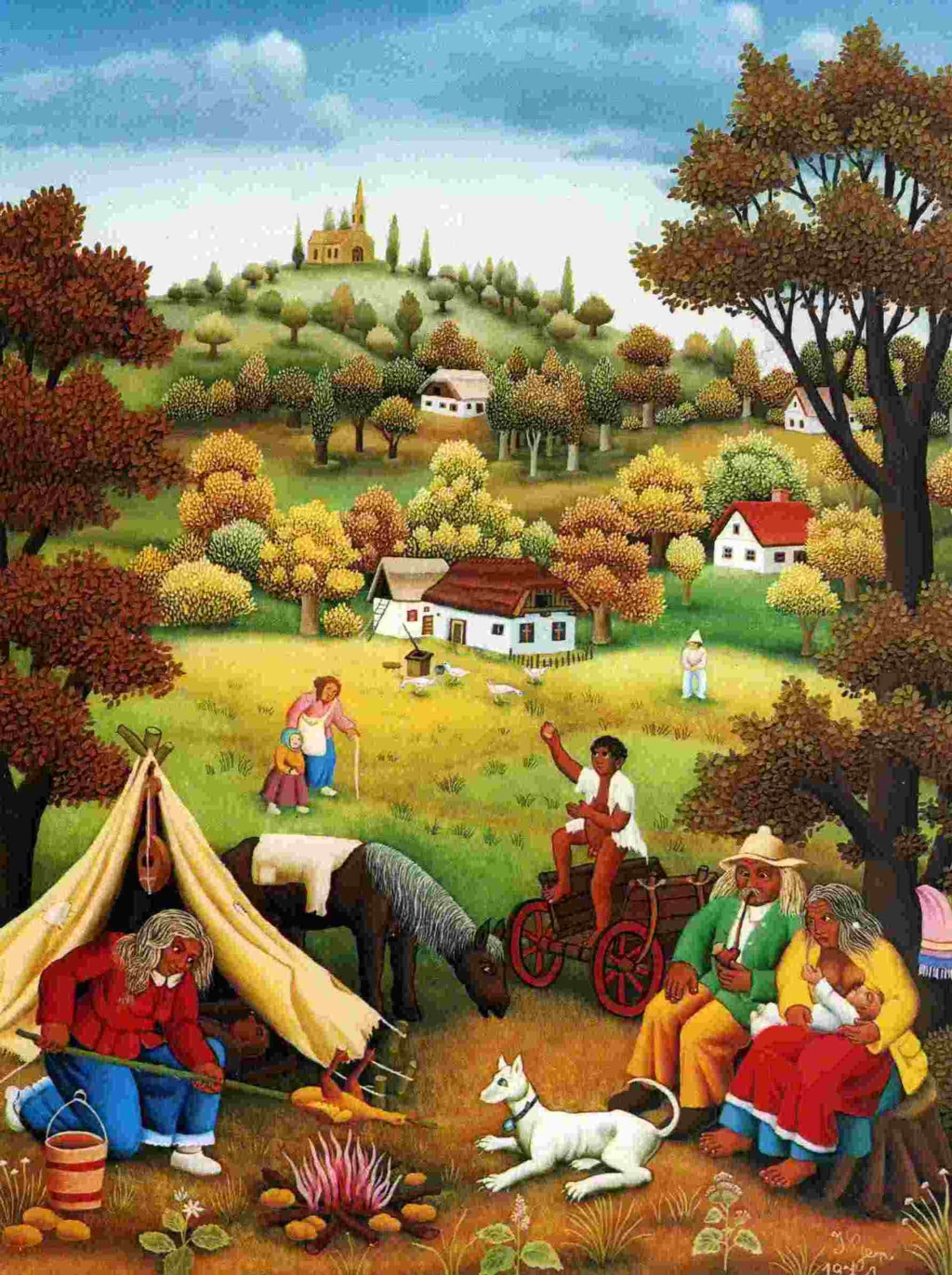
Croatian History Museum. This museum chronicles events around the year 1918 – WW I, the end of Austro-Hungarian rule and start of the Yugoslavia (Republic of Slovenes, Croats and Serbia) and the Spanish flu epidemic. There were a lot of documents and newspaper clippings all in Croat. Under the secret Treaty of London (Italy, GB, France, Russia), a lot of western Croatia was given to Italy for it not joining the Germans and Austro-Hungarians in WW I. 15 KN
St. Mark’s Church. A World Heritage Site, this parish church is the symbol of Zagreb with its multicoloured tile roof composed of the coats of arms of the City of Zagreb and the Tripartite Kingdom of Croatia and its huge clock tower with a copper “onion style” dome and the date 1841 when it was added to the church.
Originally dating from the 13th century, the church was brick with frescoes on its columns and walls. In the 17th century, it had 11 altars but they were all removed in the restoration of 1922-37. The polychromes from the altars are in the City Museum of Zagreb.
This church is oddly closed to tourists as the priest does not like them visiting. I returned at the 6 pm service and had a look (the open door is the smaller west one). There were 11 in the congregation including 2 nuns. It has plain grey walls with 3 huge murals on each of the sidewalls, equal-height aisles and nave and rib vaulted ceilings painted in gold leaf. Free
Zagreb City Museum. I spent a long time here, not because it is good but because it is so large taking up 3 floors. Each room has a storyboard in English but all the labels of each artifact are in Croat. There are bits of poor archaeology from the 9th and 7th BC, 1st, 7th and 12th centuries. 1094 was the first time the name Zagreb appeared in records. A royal fort was built in the middle ages and 130 witches were burned at the stake until 1756 when that was outlawed. The Ottomans attacked requiring reinforcement of all the walls in 1476-78 and 1512 (they were unsuccessful for once). Some of the more interesting exhibits were on guilds, the Order of the Poor Clares (nuns who started the first school), the start of the Croat national revival in the 1840s and promotion of the Croat language from 1860, abolishment of the feudal system in 1848, WW I, WW II and the start of the communist state. 40 KN
Tortureum. This uses a tablet to give gruesome accounts of about 30 objects used in torture, most truly horrific. Many of the objects are recreated. I am not sure if this is worth the admission cost. A mood is created with low lighting and black walls and curtains. 40 KN, 30 reduced.
Mushroom Museum. In the NM “Bizzarium” series, there are at least 1600 specimens mounted on small disks of tree trunk, all collected by a now elderly professor and his friends. They are all crammed into glass cases and it gets overwhelming. The Latin scientific name and common name in Croat is frustrating and I had difficulty recognizing the few mushrooms I know. Most specimens have “choice”, “edible”, “poisonous”, or “of no value” in English. It is hard to find, on the second floor of a large building. The old glassed elevator is nice. 20 KN, 15 reduced

Dolac market. This large, indoor market is about ¾ meat, ⅛ cheese and the rest an assortment of veggies and bread. There are no food stalls.
Zagreb Cathedral. The first 12th century church was burned by the Tartars in 1242 and it was rebuilt starting in the 13th century and finally finished in 1510. The gorgeous 1643 main portal was later demolished and sits in the City museum. Two fires required other rebuilds. All the marble altars were added then. The final restoration took place in 1885.
It is a grand building with very high, equal-height aisles and a nave, but is dimly lit. The rib vaulted ceiling, huge columns and walls are all grey stone. There are many marble altars, a nice geometric floor and wood inlay choir stalls. The imposing tomb of Alojzije Stephanae has a central position behind the altar with bronze bas-relief detail (unfortunately the printout was only in Croat and I learned nothing about him). Free

Zagreb 360° Observation Deck. On the 16th floor of a black glass skyscraper, an outdoor observation deck surrounds a restaurant. The best views are down to the central square and cathedral. No directional signs are pointing out landmarks. 60 KN
Modern Gallery. The temporary exhibit was a Croat artist whose abstracts were basically awful with gobs of paint running down the large canvases. Unfortunately, it was not a circle and I had to walk by all of them again. The 2nd floor had 20th century Croat artists – the many sculptures were the highlight. 40 KN, 30 reduced and not worth the price.
Strossmayer Gallery of Old Masters (Croatian Academy of Sciences and Arts). In a gorgeous building with marble everything and an open central courtyard, most of this building consists of offices. The Strossmayer collection surrounds the courtyard on two floors and includes a gallery of portraits. It was no very interesting art. Free Several side rooms have religious art and require a ticket – needless to say I skipped this – how many bambinos and virgin paintings can one see? 30 KN
Art Pavillion. In another grand building, has changing temporary exhibits – the present one called Let Them Eat Cake. 40 KN, 30 reduced.
Typhlological Museum. This whole building seems to cater to blind people – I have never seen so many people with white canes. This museum showcases the first public school for the blind in Croatia (1906), and the development of Braille (originally based on quipo, the Inca system of ropes and knots), it was first invented in 1825 but took 70 years to become accepted. Speech synthesizers have revolutionized access for the blind. Three blind artists are profiled, all doing sculpture. The highlight may be the “Dark Room” where you are required to do simple tasks in complete darkness. This is an impossible museum to find as the only sign is high amongst several similar small signs and is in Croat – Tifloski Museum – and is on the 2nd floor of the inauspicious building. 20 KN, free reduced Zagreb Botanical Garden. A department of the University of Zagreb, there were no flowers in bloom but this lovely, large garden has many mature trees (some over 100 years old but the heavy loam soil and pollution cause reduced lifespans), several rockeries (karst, alpine, west European, and Mediterranian) and several greenhouses. I have never figured out why botanists don’t have the common name of trees and plants in the native language and English. It would not be hard to do and would greatly improve public knowledge.
Mimara Museum. Opened in 1987, this is the collection of Ante Mimara (1918-1987) and opened in 1987. This is a great museum with concentrations on glass (the many completely intact ancient glass and Venetian glass are tremendous), ivory, polychrome religious art and a great many small bronzes. The 3rd floor has paintings of some famous guys and a lot of furniture. 40 HK, 30 reduced and 20 with Zagreb Card (this was where I found out the card gives reductions to several museums).
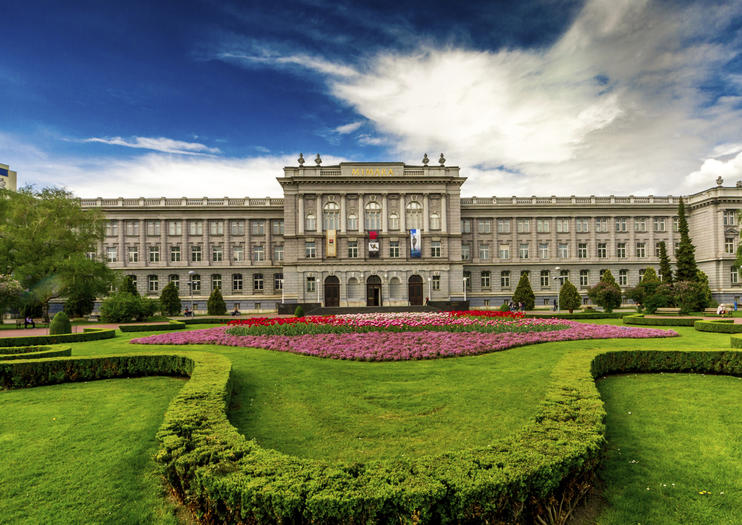
Ethnographic Museum. I have learned to dislike these as they are so repetitive – costumes, farm tools, old furniture. 30 HK
Museum of Arts and Crafts. The 3rd floor has clocks and watches, the 2nd furniture, ceramics and metal work and the 1st religious art, tapestries and more ceramics. Free with Zagreb Card.
I was up early, headed for a Mcdonald’s to mooch internet and saw these before getting my oil change in northwest Zagreb.
Tvornica Kulture (Black Rebel Motorcycle Club). In the NM “Entertainment/Things to do” series, this nightclub/bar/coffee shop has a small stage in the coffee shop area and a large room in the back with a big stage and floor seating. It is a common performance venue with music mostly. Everything here is painted black.
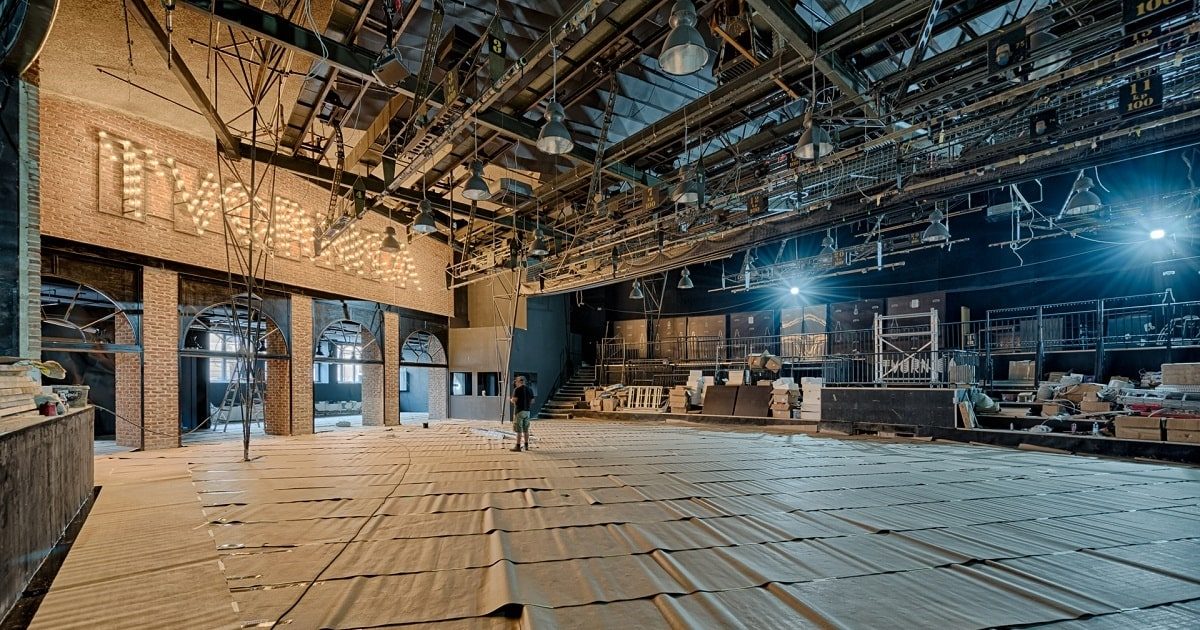
Maksimir Park. This huge park was the first public park in southern Europe created in the early 1800s. Once outside the city limits on the slopes of Mount Medvuenea, it is now totally surrounded. It has mature trees, bush and lots of water in lakes, ponds and canals.
Zagreb Zoo. In the centre of the park, this zoo is set in big trees and ponds. There is the full repertoire of critters. Free with Zagreb Card.
Museum of Contemporary Art. This huge modern museum has 3 floors of wonderful exhibition space. It seemed that most of the art dated from over 30 years ago. I especially enjoyed the graphic computer art dating from the ’60s and ’70s when data was entered on pre-perforated cards and paper ribbons. There was also an exhibition of plaster masks displayed on metal rods – each had a riveting story of women from an emergency house who had left their abusive relationships or had contracted HIV at a time when there was no viable treatment.
Arena Centar. Next to the new arena, this modern 2-story shopping mall has all the usual stores.
I then went for my oil change at a Skoda dealer in NW Zagreb. With tire rotation and a new ventilation filter, the cost was a whopping 2324.53 HRN or €312.86. Unbelievable as in Canada an oil change for my diesel truck is about €55. Apparently, this is a fixed cost across all VW dealers throughout Europe. He said it was because diesel takes a lot of oil (7.5l; my truck needs 10l) and the oil cost 167 KN/litre or €22.60/litre but he gave me 25% off. One saving grace is that it needs an oil change (due to amazing VW technology) only every 35-40,000 km (it is a calculated distance based on the amount of city versus highway driving). But this will be the last time I go to a VW dealer. He was a very pleasant fellow with great English.
Westgate Shopping City. About 15 km north of Zagreb, this is another large 2-story shopping mall. Slightly dated, it also has all the usual stores.
The mall was the last thing I saw in Croatia and I drove the 25kms to the Slovenia border, easily the easiest border crossing of the entire trip. They did not ask for registration or insurance and didn’t check the inside of the van (the first time that has not happened).
I crossed back into this part of Croatia (Međimurje) on May 19 at 11 am. the Slovenian border didn’t even have a post. The Croats asked to see the vehicle registration.
ČAKOVEC
Medjimurje County Museum. In a large yellow 4-story manor house with a large courtyard (with odd geometric metal sculptures) is this museum on local history and ethnography. 20 HRK
Čakovec Castle (Zrinski Castle). This medieval castle of brick and stone has a large clock tower and is presently being completely renovated.
VARAZDIN (pop 47,000)
Varaždin is a city in Northern Croatia, 81 km (50 mi) north of Zagreb and located near the Drava River. It is mainly known for its baroque buildings, music, textile, food and IT industry.
History. The first written reference to Varaždin, whose historical name is Garestin, was on 20 August 1181, when King Béla III mentioned the nearby thermal springs (Varaždinske Toplice) in a legal document. Varaždin was declared a free royal borough in 1209 by the Hungarian King Andrew II. The town became the economic and military centre of northern Croatia. Due to Ottoman raids, the town was structured defensively around the old fortress and acquired the shape of a typical medieval Wasserburg. In the early 13th century, the Knights Hospitaller came to Varaždin, where they built a church and a monastery.
At the end of the 14th century, Varaždin fortress passed to the hands of the Counts of Celje. Over the following centuries, Varaždin had several owners, In 1756, the Ban Ferenc Nádasdy chose Varaždin as his official residence, and Varaždin became the capital of all of Croatia. With the arrival of the Jesuits, the school and the Jesuit house were founded, and churches and other buildings were built in the Baroque style. In the 18th century, Varaždin was the seat of many Croatian noblemen, and in 1756 it became the Croatian administrative centre. The fire of 1776 destroyed most of the town, resulting in the administrative institutions moving back to Zagreb.
Varaždin was the seat of the Varaždin County of the Kingdom of Croatia-Slavonia within the Austro-Hungarian monarchy, ruled by the Kingdom of Hungary after the compromise of 1867. The Hungarian stamp, issued in 1881 shows both names. By the 19th century, Varaždin had been completely rebuilt and expanded, with flourishing crafts and trade, and later the manufacture of silk and bricks. The theatre, music school, and fire department were founded.
In the 20th century, Varaždin developed into the industrial centre of Northwestern Croatia. The textile manufacturer Tivar was founded in 1918. In the Croatian War of Independence, 1991, Varaždin suffered directly for only for a few days, because the huge Yugoslav People’s Army base quickly surrendered, resulting in a minimal number of casualties, and providing weapons (worth $600m) for the Croatian army.
There are many baroque and rococo palaces and houses in the town. Worth particular mention is Varaždin’s Croatian National Theatre, built in 1873. A baroque music festival has been held annually in Varaždin since 1971 and attracts some of the finest musicians and their fans from Croatia and the world. Recommended to visitors is also the historical street festival Špancir Fest every September.
Varazdin – Historic Nucleus and Old Town are tentative WHS (01/02/2005). This is a lovely Old Town, all pedestrianized with a great atmosphere as no new buildings or knick-knack stores are displaying their wares on the street. The squares are full of sidewalk restaurants.
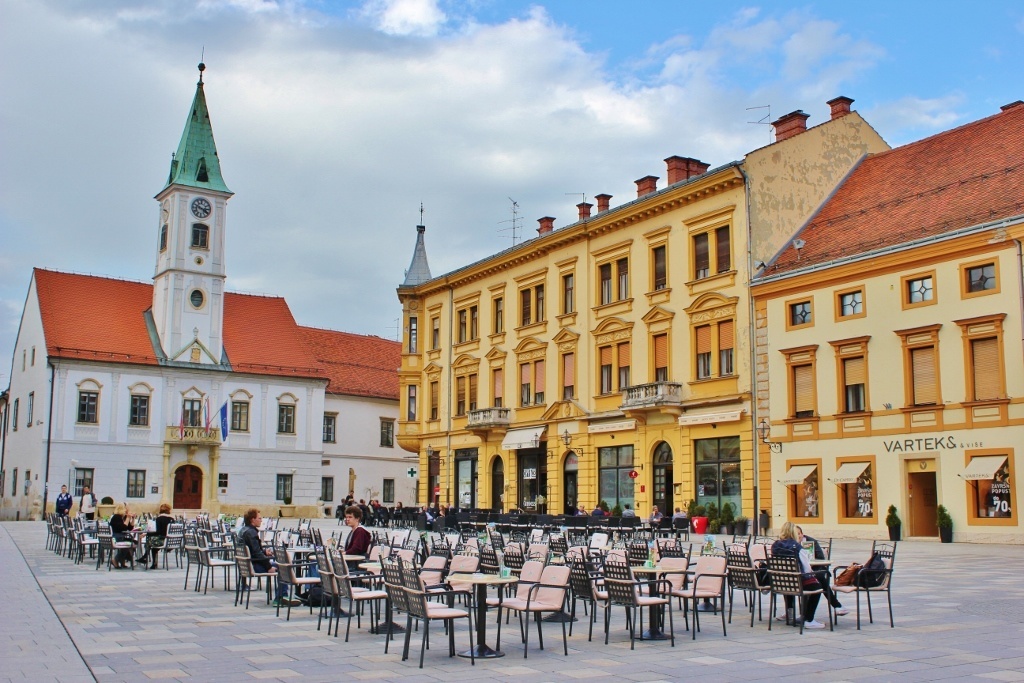
Old Fort and Varazdin City Museum.
The Old Town (fortress) is an example of medieval defensive buildings. Construction began in the 14th century, and in the following century the rounded towers, typical of Gothic architecture in Croatia, were added. Today it houses the Town Museum. The fortress is depicted on the reverse of the Croatian 5 kuna banknote, issued in 1993 and 2001.
This large white fort is partially surrounded by a high grassy bank. The entire fort is occupied by the museum surrounding a central courtyard. The exhibits are weapons, fashion, wood chests, glass (Czech, Venetian), porcelain, and a lot of rooms decorated with period furniture. The wood floors are nice. 25 HK, 15 reduced but I had no cash and my credit card didn’t work so they let me in for free!
Sisak People’s Liberation Partisan Detachment Monument (Monument to the Revolution Moslavine). This was a long 21km drive each way off the highway. It is a World War II memorial sculpture by Dušan Džamonja, located in Podgarić, Croatia. It is dedicated to the people of Moslavina during World War II.
This was a long 21 km drive each way.
